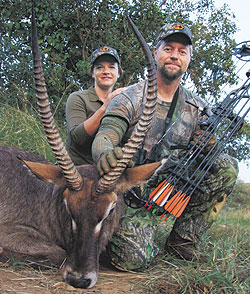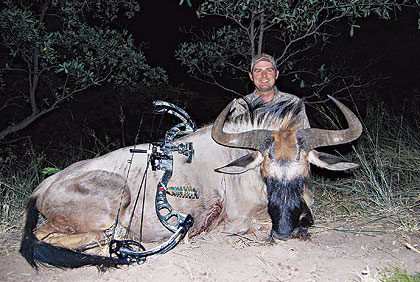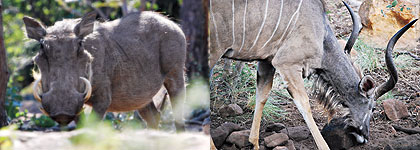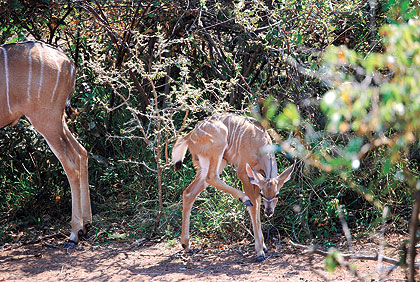October 28, 2010
By Tony Peterson
The "Off-Season" Pursuit Of Plains Game.
By Tony Peterson
 John Bowen arrowed this trophy Waterbuck while hunting with the author at Kunkura Lodge in the Limpopo region of South Africa. |
I got the nod at our staff Christmas party that I would be going to South Africa in the spring of 2008 to hunt. Traveling with me would be the winner of PSE Archery's Wild African Adventure John Bowen and his wife Linda. That got us both started on a whirlwind of preparation and planning. I picked the brain of a few Africa veterans, including BOWHUNTING Adventures Editor Patrick Meitin. One common theme that cropped up through the conversations was that, given the time of year, the hunting would be extremely hit or miss depending on rainfall.
Advertisement
I met John and Linda at the airport in Atlanta. After quick introductions, we readied ourselves for 20-plus hours on the plane. Little did we know mechanical problems would strand us for more than six hours and then again for three hours as we refueled in Dakar, Senegal. Travel weary and exhausted, we finally arrived in Johannesburg only to learn our luggage would be late due to broken conveyer belts. Needless to say, there was a growing concern within our little traveling threesome that the whole trip might be destined to follow a similarly bumpy path.
Advertisement
Finally...
Jaco, the go-to guy at Kunkura Lodge, picked us up at the hotel. The three-hour drive we took to the Limpopo region in the northern part of the country was punctuated by animal sightings and frequent stops at tolls.
We hammered Jaco with questions the whole time and were greeted upon our arrival by lodge owner Nico Pelser and his son Willie. In short order we were welcomed and shown our cabins. After settling in, John and I hit the range to make sure our X-Force bows were still shooting well. Then, Willie gave us a tour of the ranch and showed us some of the blinds where we would be spending much of the coming week.
Countless sightings of warthogs, wildebeest, nyala, eland, kudu, impala and other game greeted us as we drove along. Every exotic animal stationed just off of the road lifted our spirits a little more. By the end of the tour, 30-plus hours of stressful travel had been utterly erased and replaced with contentment – and a strong urge to go hunting.
It Begins...
The main concern with hunting Africa in April is there is still a good possibility of rain, something that literally puts a damper on waterhole hunting. Our opening morning was beautiful, with temperatures in the low 60s. Willie dropped John and Linda off at a blind and then took me to a different waterhole, wishing me luck as he departed.
A complete sense of wonderment filled me as the sun rose into the sky and started the temperature on a quick ascent. Almost immediately, I thought I heard the soft clink of hooves on rock but wasn't too sure I could trust my hunter's senses that had been dulled by a long Minnesota winter. Before I knew it, I was looking up from ground level at a dozen greater kudu cows and one young bull. They drank quickly and took off, their absence filled immediately by a nice red hartebeest circling my blind to get downwind.
The experience was surreal, a feeling that was only heightened when I lost sight of the hartebeest but found myself staring at a herd of impala nervously approaching. A ram of 21 or 22 inches brought up the rear.
 The author was lucky enough to take this blue wildebeest on the first day. Due to a little "wildebeest fever" the shot was made quartering to, but the efficiency of modern bows and sharp broadheads did the trick. The bull was recovered only 150 yards from the blind. |
An hour into Africa, you couldn't convince me I was anywhere near the off-season, and it didn't seem like any amount of rain could hinder my chances, because game was literally everywhere. I watched the impala ram approach the salt lick planted 20 yards from my blind. Drawing my bow and sort of settling in, I punched the release only to watch my arrow sail at least six inches over his back. Obviously, I had been afflicted by a sudden case of "impala fever."
The impala didn't stick around waiting for me to blow another shot, but plenty of other animals showed up over the course of the morning. Even a few younger impala rams tested their luck, but nothing I wanted to shoot. When Willie dropped off my lunch, he told me John had scored a nice blue wildebeest.
Throughout the afternoon, I snapped photos of impala, kudu and warthogs while waiting for a "shooter" of any sort. As nightfall closed in and shadows fell across the land, I started to think my first day would end with just one embarrassing miss. But, just like in the world of whitetails I grew up in, I shouldn't have resigned myself to such a fate.
In an instant, the cracking of limbs and the flash of blue-gray animals commanded my attention. Everything from zebra to eland flashed through my mind as I tried to figure out what was circling my blind. Trotting head on, the first blue wildebeest answered my question. All the things
Nico and Willie told us disappeared in an instant. As the original wildebeest was joined by more from the herd, I realized I couldn't remember if I was supposed to look for a black face or not shoot one with a black face. I knew I was supposed to look for big bosses and a good spread, but the animals in front of me all looked the same.
I was pretty sure the first one to come in was a nice bull, so I did the only thing I knew to determine the sex of an animal -- I looked for a certain part indicative of males. When the wildebeest finally turned, I caught a glimpse of all I needed to see. I drew in the fading light, settled my sight pin behind the shoulder and hit my release. The waterhole exploded with animals, and I was confident I had made a good shot.
Shortly, Willie showed up and we started the tracking job with Chupata, one of his two pit bull/terrier mixes. Willie found my arrow stuck in the ground a good 20 yards beyond where the animal had stood, reminding me just how efficient modern archery equipment is. He questioned me about the angle of the shot, because there was some gut material on it. I was sure the animal was quartering away, so we continued on.
He soon pointed out walking tracks in the sand from my wildebeest and told me this might not work out given a gut shot wildebeest's propensity to walk for miles until they collapse. Hesitantly, he went down the trail a little farther and whistled back to me. I
walked over and saw my first African animal lying dead, not 150 yards from where I had shot him.
A Mid-Week Blur
The days flew past as we spent sunrise to sunset watching animals and trying to get shots. Each day, John (with Linda dutifully in tow) and I had opportunities, and for the most part they turned out pretty well. John quickly scored on a beautiful waterbuck, as well as a baboon and warthog. I shot a warthog on the second day and set my sights on a nice impala and a kudu or a gemsbok.
 Because the owners of Kunkura are hardcore archery hunters, they set their clients up for close shots on all game. Nothing can prepare a first-time African hunter for the thrill that comes from in-your-face encounters with a variety of plains game. |
The third day, I was perched in an elevated blind when four impala rams walked in. One was young, two were wide and tall and definitely shooters, but the last one was an obvious stud. His horns were heavy, though not terribly long or wide. His body size and the way he walked told me all I needed to know.
In an effort to redeem myself in the impala department, I waited for him to turn and mentally told myself to aim low and forward because of the way most African animals' vitals are situated. Fighting a lifetime of "behind the shoulder" thinking, I settled my pin where I thought it should be and squeezed the release. The arrow hit hard and skipped through the impala. As he ran off, I could see his front right leg was injured, though it didn't stop him from leaping six or seven feet into the air.
A radio call to Willie brought him, Nico and two of their trackers out to find the ram. Profuse lung-blood greeted us on the trail, and I shadowed Willie through the bush as he scanned ahead. His eyes proved quite adept as he spotted my ram bedded and ran back to tell me to get ready for a follow-up shot.
Immediately, I felt tension run through my body. My shooting confidence had already taken a hit due to the excitement the African animals instilled in me. Plus, Nico and Willie are extremely accomplished bowmen who have taken hundreds of game animals. Now, these guys were my audience in a pressure-packed situation.
When Willie whistled to get my ram to stand up, I shot well over its back. They were more than understanding as my impala ran away, though I suspect their calm demeanor stemmed more from professionalism than anything. Once we caught up to the ram, which we would later discover had only been hit in one lung, I was offered another shot with Willie looking over my shoulder. Thankfully, I connected and that was the last place that particular impala ever bedded. The rush of stalking a wounded animal through the African bush actually made me light-headed, and I suddenly had a new appreciation for the hardiness of the animals that inhabit the Dark Continent.
The End Is Near
I spent the last half of the week looking for a nice kudu, but I really wanted a big gemsbok. When a beautiful bull with his straight, heavy black horns finally walked in and stood at eight yards, I started thinking about the taxidermy bill I'd be faced with back in the states.
As the bull turned, I started to draw and, this is no lie, had a squirrel bark at me. This spooked the gemsbok, and when he stopped, brush prevented a shot. As the bull walked out of my life, I silently cursed the African squirrel the same way I deride the grays and reds back home in Minnesota.
Not surprisingly, the days spent hunting and nights spent eating phenomenal local cuisine around the campfire flew past. Linda, John and I were having too much fun, and before we knew it, the last day of our hunt was upon us.
 This young kudu was one of the countless non-target animals that came in to water. Because of the abundance of game, there is very little down time while hunting in Africa. |
I was placed in the elevated blind in an attempt to get a chance at a big kudu bull. A huge baboon troupe lead by an old male kept me company all morning, giving the other animals confidence to visit the waterhole. Young kudu and multiple warthogs visited, but nothing else. As lunchtime approached, the big male baboon started to look pretty tempting.
At the beginning of the hunt, a baboon was not on my trophy list. But after watching them for six days, I realized they were comparable to wild turkeys -- they don't seem to rely on their noses, but they sure can hear and see extremely well.
My decision was made when he left the waterhole only to turn around and sit down facing away from me at 20 yards. As I drew, one of the other males standing guard sounded off and the big male started walking. But it was too late for him as I hit the trigger and watched the arrow center-punch him.
When Willie showed up, we tracked just 40 yards before recovering the old male. After taking pictures, Willie told me John had arrowed a nice impala. The last day was certainly shaping up as a perfect end for both of us.
The Final Night
That evening, Willie stationed me in a temporary blind on a "dam," which is a term for a pond or lake in Africa. It didn't take long for a nice warthog to work down the rocky hillside in front of me. It was a female with young, so I snapped some photos and enjoyed the show.
After they left, with the sun sneaking below the horizon, a group of four kudu bulls approached. The largest had two curls but was just shy of what I considered a shooter. I watched the bulls for a long time, vacillating between the "should I" or "shouldn't I" thoughts that come with seeing a beautiful animal in bow range on the last night of the hunt.
Eventually, they made the decision for me by walking up a hill to meet a large herd of cows.
With the last hour of light upon me, I was snapped to attention by the crashing of the whole kudu herd through the scrub brush and rocks above me. Glimpses of tan hides streaked past in a way I had never seen before. Then, I heard a sound I will never forget. It was almost like someone sawing through a board with a handsaw, but more guttural and alive.
A leopard had made its way into my setup and spooked the herd. Earlier in the week, I thought seeing a live leopard would be unbelievable. But now, alone in a mesh blind with only a b
ow for my defense, a real live leopard within 60 yards was a different matter entirely.
Every stick that snapped behind me caused my imagination to race well beyond wild. But, like the zebras that circled the blind giving themselves away through occasional whinnies, the leopard made its presence known only through its call. The sound of Willie's truck approaching in the dark was most welcome.
It was time to go home.
